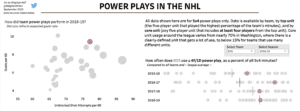Boston Bruins
The Power Play: High Risk, High Reward

If you are a relatively new NHL fan, everything seems normal. But if you lived through the ‘dead puck era’ then you remember the painful, low scoring games. The average NHL power play bottomed-out at 15.06% in 1997-98.
In recent years, the average power play has been operating at an impressive 20%; levels not seen since Wayne Gretzky made a circus act out of the man-advantage. The pace of change in the NHL, including thoughtful rule changes towards offence and coaching tactics, has made the power play an exciting element of the game once again.

Teams continue to be more aggressive in the pursuit of scoring, including icing more forwards on the powerplay than in the past. Meghan Hall’s research shows the increase use of four forwards on the power play league-wide. In each of the last four seasons, Boston Bruins used the 4F/1D formation on the power play at a rate higher than the NHL average as shown by the highlighted bubbles in the graphic below.

The percentage of time the Boston Bruins used 4F/1D on the power play:
| Season | NHL Average | Boston Bruins |
| 2015-16 | 52% | 63% |
| 2016-17 | 58% | 84% |
| 2017-18 | 67% | 72% |
| 2018-19 | 73% | 73% |
Proof of aggressiveness on power play is further shown in the increase in number of short handed goals against. In the top graph below you can see that the Bruins power play has been excellent; well above league average since 2015-16. But the bottom graph shows the number of short handed goals against is also on the rise, and the Bruins are well above the league average in this category too. It is interesting to note that, the Bruins saw a sharp increase in short handed goal against even though they deployed more defensemen (as a percentage of their formation) on the power play in the past two seasons.

Last season, the Bruins share the dubious distinction of having the most short handed goals against with the Pittsburgh Penguins; a team that also boasts a strong, if not high-risk, power play.
It begs the question, are all the strong power plays also ‘high risk’? Definitely not. The Tampa Bay Lightning had the best power play in the NHL last season. They also deployed more forwards on the power play than any other team in the league. And they only had three short handed goals against. Only three teams had fewer short handed goals against. (data as per hockeyreference.com)
Last season the Bruins had the 3rd best power play percentage at 25.9 %. However, if we factor in the short handed goals against for each team (15 for the Bruins), the Bruins ‘true’ power play percentage drops to under 20%, and becomes the 6th best percentage in the NHL.
Does this mean they should to deploy more defencemen on their powper play units? If we look at the three teams that deploy defencemen on the power play the most – Nashville, Minnesota and Arizona, only one team saw real success. Minnesota had a slightly above-average power play percentage at 20.33%, and allowed only three short handed goals against. When applying the ‘true’ power play formula (power play goals minus short handed goals against), the Wild’s power play percentage is very close to the Bruins.
However Nashville and Arizona, even with a comparatively high percentage of defencemen on their power play, allowed 8 and 9 short handed goals against respectively. They also had bad power plays.
This season, the Bruins have their work cut out for them. They should definitely strive to reduce the number of shorties against, while, of course, keeping that incredible power play goal rate high. So far, in this young season, the Bruins do not have a single short handed goal against.


